
a.
To calculate:Themissing dimension of given figure.
a.
Answer to Problem 8PSB
The missing dimension are
Explanation of Solution
Given information:
Area of rectangle:
In Figure 1, other side of
In Figure 2, other side of
In Figure 3, other side of
In Figure 4, other side of
Formula used:
Area of rectangle:
w = width of rectangle,
l = length of rectangle.
Calculation:

In Figure 1,
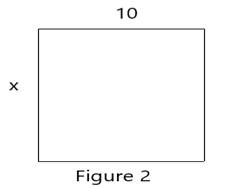
In Figure 2,

In Figure 3,
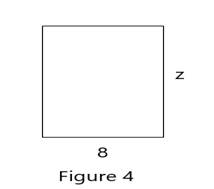
In Figure 4,
b.
To calculate: The length offencing needed to surround each figure.
b.
Answer to Problem 8PSB
The length of fencing needed to surround Figure 1 is
Figure 4 is
Explanation of Solution
Given information:
Area of rectangle:
In Figure 1, other side of
In Figure 2, other side of
In Figure 3, other side of
In Figure 4, other side of
Formula used:
Perimeter is sum of all sides.
Perimeter of rectangle:
where b = breadth of rectangle,
h = height of rectangle.
Calculation:

In Figure 1,
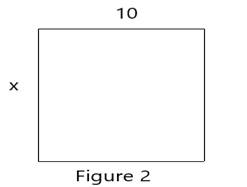
In Figure 2,

In Figure 3,
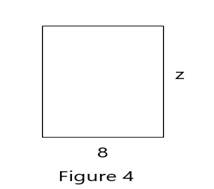
In Figure 4,
c.
To find: The figure with a shortest perimeter.
c.
Answer to Problem 8PSB
The figure with shortest perimeter is Figure 2.
Explanation of Solution
Given information:
Area of rectangle:
In Figure 1, other side of
In Figure 2, other side of
In Figure 3, other side of
In Figure 4, other side of
Formula used:
Perimeter is sum of all sides.
Perimeter of rectangle:
whereb = breadth of rectangle,
h = height of rectangle.

In Figure 1,
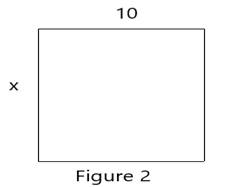
In Figure 2,

In Figure 3,
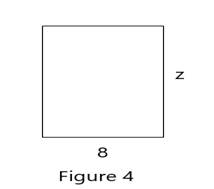
In Figure 4,
The shortest perimeter is 40.
The figure with shortest perimeter is Figure 2.
d.
To find: A rectangle that encloses the maximum possible area with the shortest possible perimeter.
d.
Answer to Problem 8PSB
A rectangle that encloses the maximum possible area with the shortest possible perimeter must be a square.
Explanation of Solution
Given information:
A rectangle with maximum possible area and shortest possible perimeter.
Formula used:
Area of rectangle:
w = width of rectangle,
l = length of rectangle.
Perimeter is sum of all sides.
Perimeter of rectangle:
b = Breadth of rectangle,
h = Height of rectangle.
The rectangle having the maximum possible area for a shortest possible perimeter is square because the length and width are the same.
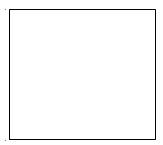
Area of square is given by product of length and width.
In square, all sides are equal.
The magnitude of area will be larger because both values of length and width are same.
In case of other parallelogram, the length and width are different. This will result into area of certain value which is not as great as square.
Chapter 11 Solutions
Geometry For Enjoyment And Challenge
Additional Math Textbook Solutions
Introductory Statistics
A First Course in Probability (10th Edition)
Intro Stats, Books a la Carte Edition (5th Edition)
Elementary Statistics (13th Edition)
Elementary Statistics
University Calculus: Early Transcendentals (4th Edition)
- 18:36 G.C.A.2.ChordsSecantsandTa... จ 76 完成 2 In the accompanying diagram, AABC is inscribed in circle O, AP bisects BAC, PBD is tangent to circle O at B, and mZACB:m/CAB:m/ABC= 4:3:2 D B P F Find: mZABC, mBF, m/BEP, m/P, m/PBC ← 1 Őarrow_forward14:09 2/16 jmap.org 5G 66 In the accompanying diagram of circle O, diameters BD and AE, secants PAB and PDC, and chords BC and AD are drawn; mAD = 40; and mDC = 80. B E Find: mAB, m/BCD, m/BOE, m/P, m/PAD ← G.C.A.2.ChordsSecantsand Tangent s19.pdf (538 KB) + 4 保存... Xarrow_forward16:39 < 文字 15:28 |美图秀秀 保存 59% 5G 46 照片 完成 Bonvicino - Period Name: 6. A right regular hexagonal pyramid with the top removed (as shown in Diagram 1) in such a manner that the top base is parallel to the base of the pyramid resulting in what is shown in Diagram 2. A wedge (from the center) is then removed from this solid as shown in Diagram 3. 30 Diogram 1 Diegrom 2. Diagram 3. If the height of the solid in Diagrams 2 and 3 is the height of the original pyramid, the radius of the base of the pyramid is 10 cm and each lateral edge of the solid in Diagram 3 is 12 cm, find the exact volume of the solid in Diagram 3, measured in cubic meters. Show all work. (T 文字 贴纸 消除笔 涂鸦笔 边框 马赛克 去美容arrow_forward
- Answer question 4 pleasearrow_forward16:39 < 文字 15:28 |美图秀秀 保存 59% 5G 46 照片 完成 Bonvicino - Period Name: 6. A right regular hexagonal pyramid with the top removed (as shown in Diagram 1) in such a manner that the top base is parallel to the base of the pyramid resulting in what is shown in Diagram 2. A wedge (from the center) is then removed from this solid as shown in Diagram 3. 30 Diogram 1 Diegrom 2. Diagram 3. If the height of the solid in Diagrams 2 and 3 is the height of the original pyramid, the radius of the base of the pyramid is 10 cm and each lateral edge of the solid in Diagram 3 is 12 cm, find the exact volume of the solid in Diagram 3, measured in cubic meters. Show all work. (T 文字 贴纸 消除笔 涂鸦笔 边框 马赛克 去美容arrow_forwardAnswer question 3 pleasearrow_forward
- Answer question 3 pleasearrow_forward38 Below triangle is isosceles. Find the value of x. 70° 60° x 20° Warrow_forwardTo approximate the length of a marsh, a surveyor walks x = 400 meters from point A to point B. Then, the surveyor turns 75° and walks 220 meters to point C (see figure). Approximate the length AC of the marsh. (Round your answer to one decimal place.) m C B 75° 220 m x marrow_forward
- . The students who attend Memorial High School have a wide variety of extra-curricular activities to choose from in the after-school program. Students are 38% likely to join the dance team; 18% likely to participate in the school play; 42% likely to join the yearbook club; and 64% likely to join the marching band. Many students choose to participate in multiple activities. Students have equal probabilities of being freshmen, sophomores, juniors, or seniors.What is the probability of the union of being either a freshman or senior? 0.07 0.44 0.50 0.25arrow_forwardWhich angles are complementary to each other? Select all that apply. 3 2 4 in 5 1 Z1 and 23 Z1 and 25 22 and 23 Z2 and 25 Submitarrow_forwardWhich angles are adjacent to each other? Select all that apply. 3 2 4 67 5 8 11 10 12 12 9 27 and 28 Z9 and 12 Z3 and 24 Z10 and Z11arrow_forward
 Elementary Geometry For College Students, 7eGeometryISBN:9781337614085Author:Alexander, Daniel C.; Koeberlein, Geralyn M.Publisher:Cengage,
Elementary Geometry For College Students, 7eGeometryISBN:9781337614085Author:Alexander, Daniel C.; Koeberlein, Geralyn M.Publisher:Cengage, Elementary Geometry for College StudentsGeometryISBN:9781285195698Author:Daniel C. Alexander, Geralyn M. KoeberleinPublisher:Cengage Learning
Elementary Geometry for College StudentsGeometryISBN:9781285195698Author:Daniel C. Alexander, Geralyn M. KoeberleinPublisher:Cengage Learning

